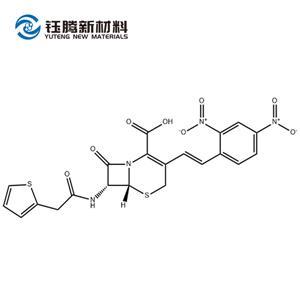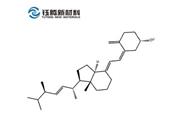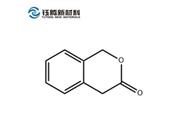Nitrocefin Applications:
Nitrocefin is a chromogenic β-lactamase substrate that undergoes colour change from yellow to red as the amide bond in the β-Lactam ring is hydrolyzed by β-lactamase. Nitrocefin undergoes colour changes induced by lactamases produced by Gram-positive and Gram-negative bacteria. Several studies have utilized the colour changing properties of Nitrocefin for the detection of β-lactamase activity from bacterial cell extracts by isoelectric focusing and spectroscopy. Nitrocefin has also been used in studies involving β-lactamase resistant antibiotics.
Chemical Properties
| Catalogue number: | TA1016 |
| TA1016 | Nitrocefin |
| Synonyms: | (6R,7R)-3-[(1E)-2-(2,4-dinitrophenyl)ethenyl]-8-oxo-7-[(2-thienylacetyl)amino]-5-thia-1-azabicyclo[4.2.0]oct-2-ene-2-carboxylic Acid; [6R-[3(E),6α,7β]]-3-[2-(2,4-dinitrophenyl)ethenyl]-8-oxo-7-[(2-thienylacetyl)amino]-5-thia-1-azabicyclo[4.2.0]oct-2-ene-2-carboxylic Acid; |
| CAS Number: | 41906-86-9 |
| Possible CAS #: | NA |
| Molecular form.: | C21 H16 N4 O8 S2 |
| Appearance: | Orange to Red Solid |
| Melting Point: | >99°C (dec.) |
| Storage: | Hygroscopic, -20°C Freezer, Under inert atmosphere |
| Solubility: | DMSO (Slightly), Methanol (Slightly) |
Nitrocefin Usage Method
1.Preparation of Cefnitrothiophene Storage Solution (10mg/ml) a) Before use, remove the product from the refrigerator and place it at room temperature for at least 20 minutes before centrifugation at low speed; b) Suck 100 μ Add 1mg of Cefnitrothiophene to high-quality DMSO, fully dissolve and mix well. It can be packaged according to a single dosage and stored in dark at -20 ° C.
2. The typical working concentration for preparing cephalosporin with a working solution of 1mg/ml is 0.5-1.0mg/ml, and this preparation is generally yellow in color. Take 20 μ Add 180 to the storage solution of Cefnitrothiophene (10mg/ml) μ After mixing with PBS buffer solution (0.1M, neutral pH), cephalosporin thiophene (1mg/ml) working solution is obtained. Excess working fluid can be stored in a dark place at -20 ° C and must be used up within 2 weeks.
3. Quick detection and analysis Once in contact β- Lactam producing bacteria, the samples to be tested can generally produce positive reaction quickly. It is usually recommended to have a reaction time of 20-30 minutes and set a negative control.
–3.1 Glass slide surface analysis method
a) Take a drop of Cefnitrothiophene working solution (1mg/ml) onto a clean glass slide surface;
b) Use a sterile inoculum ring to select a solid culture clone and mix it with liquid Chemicalbook drops evenly;
c) If red color can be observed within 20-30 minutes, it indicates that β- Lactam enzyme activity. If necessary, add more drops of Cefnitrothiophene working solution to prevent dryness
–3.2 Direct contact analysis method
a) Directly suck a drop of Cefnitrothiophene working solution (1mg/ml) onto the surface of the isolated colony;
b) If red color can be observed within 20-30 minutes, it indicates that β- Lactam enzyme activity.
–3.3 Broth culture medium analysis method
a) Take 1ml of broth culture medium and add 3-5 drops of Cefnitrothiophene working solution (1mg/ml);
b) If red color can be observed within 20-30 minutes, it indicates that β- Lactam enzyme activity.
–3.4 Cell lysate analysis method
a) Ultrasound lysis of 1ml cell suspension;
b) Add 3-5 drops of Cefnitrothiophene working solution (1mg/ml) to the lysis suspension; c) If red color can be observed within 20-30 minutes, it indicates that β- Lactam enzyme activity.
–3.5 Filter paper analysis method
a) Saturate a small piece of filter paper (~3x3cm) to absorb Cefnitrothiophene working solution (1mg/ml), and then place it in a clean culture dish;
b) Jump a separated clone and apply it to the impregnated filter paper;
c) If red color can be observed within 20-30 minutes, it indicates that β- Lactam enzyme activity.

 China
China






